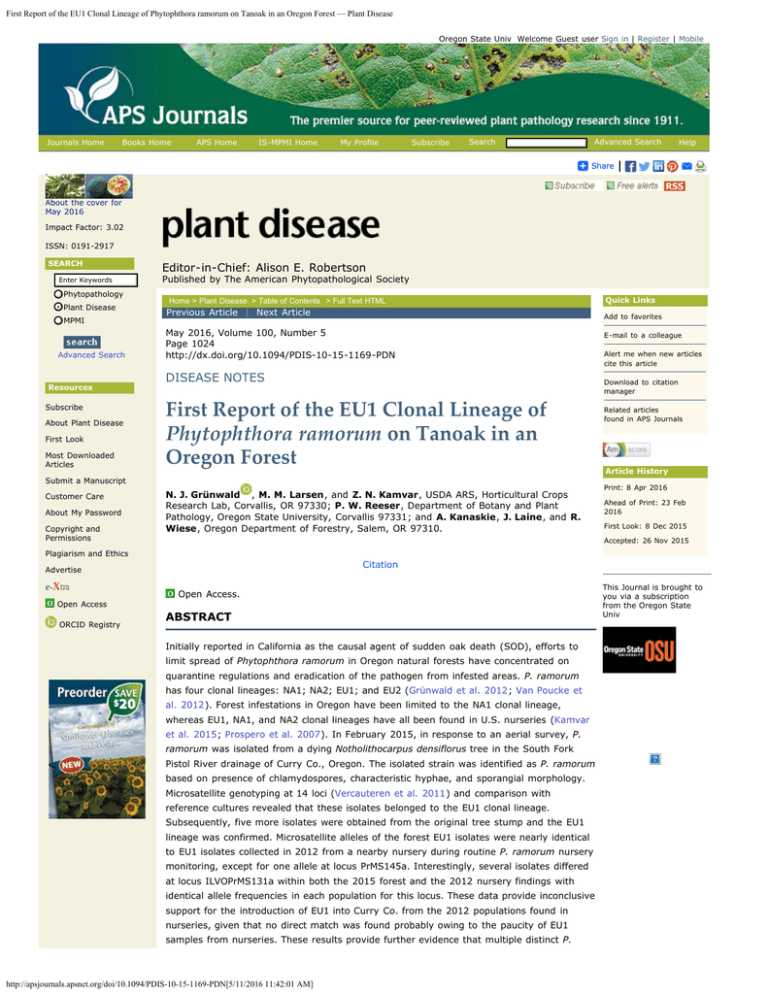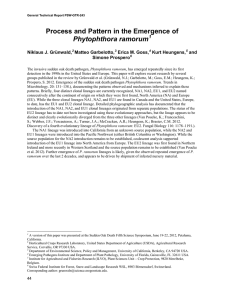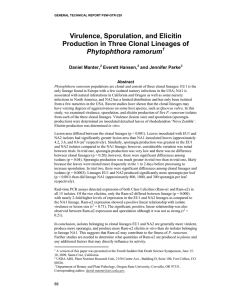Document 10439432
advertisement

First Report of the EU1 Clonal Lineage of Phytophthora ramorum on Tanoak in an Oregon Forest — Plant Disease Oregon State Univ Welcome Guest user Sign in | Register | Mobile Journals Home Books Home APS Home IS-MPMI Home My Profile Subscribe Search Advanced Search Help Share About the cover for May 2016 Impact Factor: 3.02 ISSN: 0191-2917 SEARCH Enter Keywords Phytopathology Plant Disease MPMI Advanced Search Resources Subscribe About Plant Disease First Look Most Downloaded Articles Editor-in-Chief: Alison E. Robertson Published by The American Phytopathological Society Add to favorites May 2016, Volume 100, Number 5 Page 1024 http://dx.doi.org/10.1094/PDIS-10-15-1169-PDN DISEASE NOTES First Report of the EU1 Clonal Lineage of Phytophthora ramorum on Tanoak in an Oregon Forest Submit a Manuscript Customer Care About My Password Copyright and Permissions N. J. Grünwald , M. M. Larsen, and Z. N. Kamvar, USDA ARS, Horticultural Crops Research Lab, Corvallis, OR 97330; P. W. Reeser, Department of Botany and Plant Pathology, Oregon State University, Corvallis 97331; and A. Kanaskie, J. Laine, and R. Wiese, Oregon Department of Forestry, Salem, OR 97310. Citation Advertise ORCID Registry E-mail to a colleague Alert me when new articles cite this article Download to citation manager Related articles found in APS Journals Article History Print: 8 Apr 2016 Ahead of Print: 23 Feb 2016 First Look: 8 Dec 2015 Accepted: 26 Nov 2015 Plagiarism and Ethics Open Access Quick Links Home > Plant Disease > Table of Contents > Full Text HTML Previous Article | Next Article Open Access. ABSTRACT Initially reported in California as the causal agent of sudden oak death (SOD), efforts to limit spread of Phytophthora ramorum in Oregon natural forests have concentrated on quarantine regulations and eradication of the pathogen from infested areas. P. ramorum has four clonal lineages: NA1; NA2; EU1; and EU2 (Grünwald et al. 2012; Van Poucke et al. 2012). Forest infestations in Oregon have been limited to the NA1 clonal lineage, whereas EU1, NA1, and NA2 clonal lineages have all been found in U.S. nurseries (Kamvar et al. 2015; Prospero et al. 2007). In February 2015, in response to an aerial survey, P. ramorum was isolated from a dying Notholithocarpus densiflorus tree in the South Fork Pistol River drainage of Curry Co., Oregon. The isolated strain was identified as P. ramorum based on presence of chlamydospores, characteristic hyphae, and sporangial morphology. Microsatellite genotyping at 14 loci (Vercauteren et al. 2011) and comparison with reference cultures revealed that these isolates belonged to the EU1 clonal lineage. Subsequently, five more isolates were obtained from the original tree stump and the EU1 lineage was confirmed. Microsatellite alleles of the forest EU1 isolates were nearly identical to EU1 isolates collected in 2012 from a nearby nursery during routine P. ramorum nursery monitoring, except for one allele at locus PrMS145a. Interestingly, several isolates differed at locus ILVOPrMS131a within both the 2015 forest and the 2012 nursery findings with identical allele frequencies in each population for this locus. These data provide inconclusive support for the introduction of EU1 into Curry Co. from the 2012 populations found in nurseries, given that no direct match was found probably owing to the paucity of EU1 samples from nurseries. These results provide further evidence that multiple distinct P. http://apsjournals.apsnet.org/doi/10.1094/PDIS-10-15-1169-PDN[5/11/2016 11:42:01 AM] This Journal is brought to you via a subscription from the Oregon State Univ First Report of the EU1 Clonal Lineage of Phytophthora ramorum on Tanoak in an Oregon Forest — Plant Disease ramorum introduction events into the Curry Co. forest are a critical component of the epidemic (Kamvar et al. 2015). The impact of the EU1 clonal lineage of P. ramorum on Oregon natural forests is uncertain, but it may result in potential sexual reproduction given that EU1 is of A1 mating type while the prior population consisted of NA1 A2 mating type individuals. While sexual populations of P. ramorum have not been observed in nature or were aberrant in the laboratory, the presence of both A1 and A2 mating types makes the potential for sexual recombination more likely. The EU1 forest infestation is undergoing eradication treatments. Additional monitoring is necessary to determine if the EU1 clonal lineage occurs elsewhere in Curry Co. forests. Section: References: Choose Grünwald, N. J., et al. 2012. Trends Microbiol. 20:131. 10.1016/j.tim.2011.12.006 [CrossRef] [ISI] Kamvar, Z. N., et al. 2015. Phytopathology 105:982. 10.1094/PHYTO-12-14-0350-FI [Abstract] [ISI] Prospero, S., et al. 2007. Mol. Ecol. 16:2958. 10.1111/j.1365-294X.2007.03343.x [CrossRef] [ISI] Van Poucke, K., et al. 2012. Fungal Biol. 116:1178. 10.1016/j.funbio.2012.09.003 [CrossRef] [ISI] Vercauteren, A., et al. 2011. Mycologia 103:1245. 10.3852/10-420 [CrossRef] [ISI] Citation Journals Home Books Home APS Home IS-MPMI Home http://apsjournals.apsnet.org/doi/10.1094/PDIS-10-15-1169-PDN[5/11/2016 11:42:01 AM] Contact Us Permissions Privacy Copyright The American Phytopathological Society






